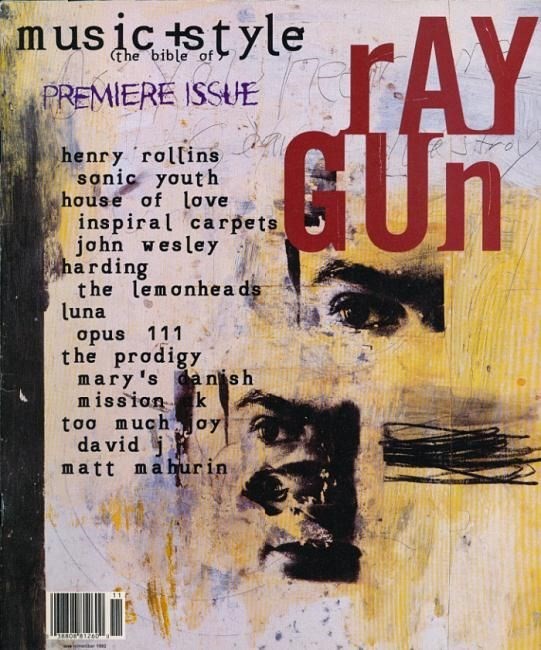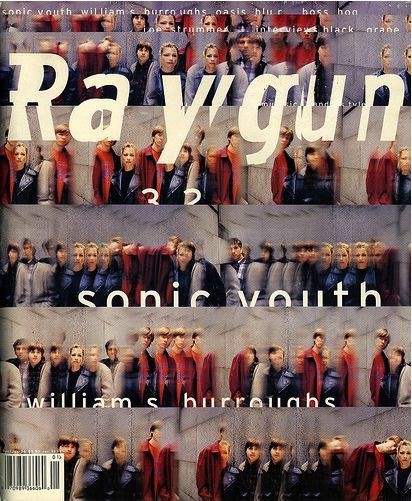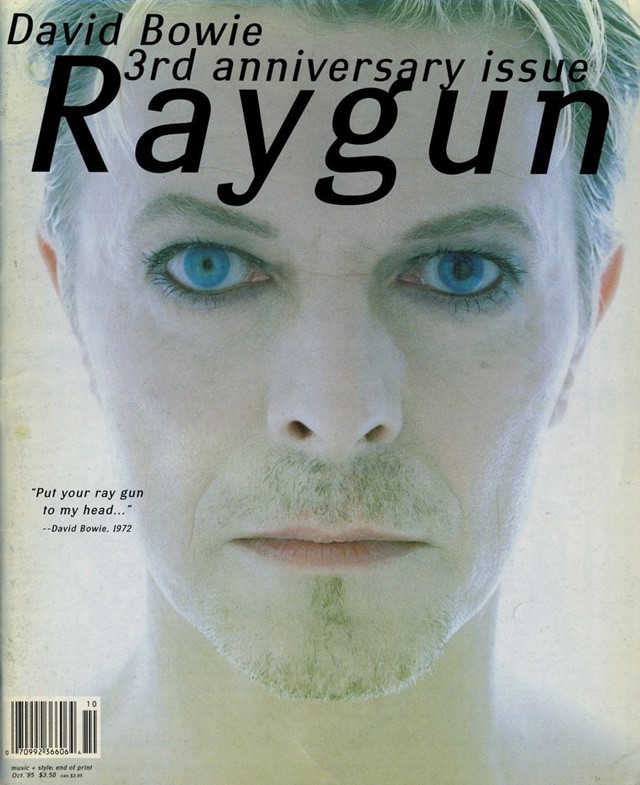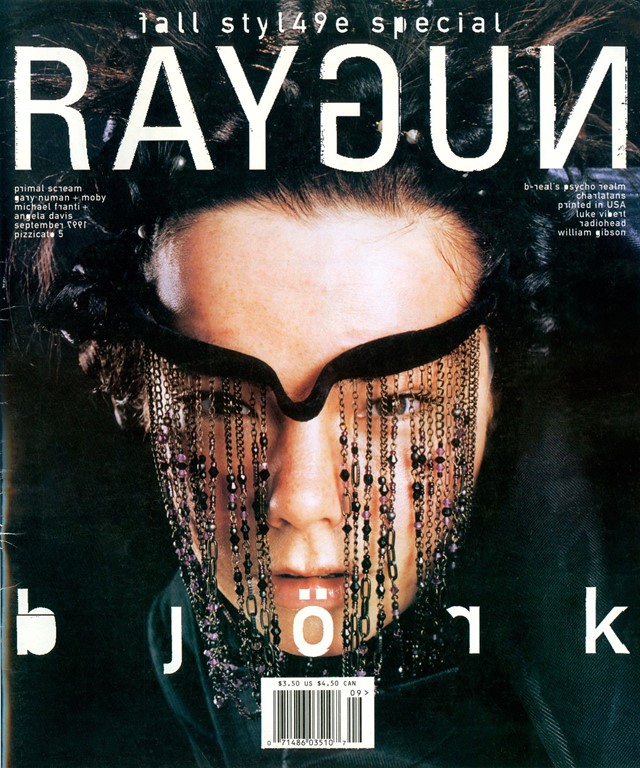Featuring upside-down pages, illegible interviews, and appearances from Sonic Youth, Björk, and David Bowie, the pioneering magazine shook up US publishing for a decade
While Jefferson Hack and Rankin were busy sewing the seeds that would eventually become Dazed & Confused in London, across the Atlantic, Marvin Scott Jarrett was coming up with the concept for a magazine that changed the face of American culture. Established in 1992 out of a tiny, one-bedroomed apartment in Malibu, Los Angeles, Ray Gun quickly became a powerhouse of music and style – as the likes of Missy Elliott, Sonic Youth, and David Bowie graced its covers, and Henry Rollins, Björk, and Iggy Pop filled its pages.
With a lifelong predilection for the eclectic music coming out of the UK and a deep love for British publications including NME and The Face, Jarrett founded the magazine with the intention of creating a radical, uncompromising publication for kids across America with whom Rolling Stone just didn’t resonate. Throughout the course of the 90s, Jarrett is credited with bringing the likes of British bands Inspiral Carpets, Blur, and Jarvis Cocker to a passionate new audience of US music fans, and introducing them to the work of European creatives including Corinne Day and Wolfgang Tillmans.
Much like the contents inside the magazine, the design and aesthetic approach of Ray Gun was pretty innovative, too. Led by art director David Carson, pages were printed back to front and upside down, leaving people wondering whether the move was intentional or not.
“Ray Gun didn’t set out to be radical or disrupt anything. We were just doing our own thing, and I think because it was authentic it ended up making a lot of noise” – Marvin Scott Jarrett
The articles themselves often went in some unique directions, too – just take the time an (apparently slightly dull) interview with Bryan Ferry ended up being published in symbol-based font Dingbats, rendering it illegible, for example. “My executive editor freaked out when it came back from the printer,” laughs Jarrett. “For me, it was in the spirit of punk rock and roll. Visually it was awesome and, somehow, it worked.” (Sadly there’s no mention of how Ferry himself reacted when he saw it).
In January 2000, just eight years after it started, Ray Gun was over, with Jarrett shutting the cult magazine down to focus on other projects (including Nylon, which he founded in 1999). Now, almost 20 years later, its legacy is celebrated in the form of a new book, Ray Gun: The Bible of Music & Style, which compiles the best covers, fashion shoots, and interviews in one place, with contributions from the likes of former cover stars Liz Phair and Flaming Lips’ Wayne Coyne.
Here, we talk to Jarrett about Ray Gun’s earliest days, his best memories of working on the magazine, and whether or not he’d consider bringing it back in 2019 (or beyond).

RAY GUN WASN’T INTENTIONALLY DISRUPTIVE
“We started it as three people in my dining room in a one bedroom LA apartment. It was me, executive editor Randy Bookasta, and my partner Jacqueline, and David (Carson) would do the art direction from San Diego. First of all, we had to think about it from a higher, conceptual level – the idea was to make a music magazine that had really cool design and production values, inspired by the alternative scene that was happening in the 90s that wasn’t so well documented in the US. But we didn’t set out to be radical or disrupt anything, that sort of just happened. We were just doing our own thing and I think because it was authentic it ended up making a lot of noise, which was fantastic. It resonated with a lot of people around the world.”
THE FIRST ISSUE WAS PROBABLY THE MOST IMPORTANT
“Of course – it set the tone for everything that was to come. When we’d got the visual style, which was the genesis for the big idea, we started thinking about and putting content together for issue one, thinking about who best represented the title. Henry Rollins was really interesting to me because not only was he this alternative punk guy, he was all about his poetry and had his own publishing company, which I thought was really cool. Sonic Youth were the quintessential, archetypical, post-punk noise band from that time, so obviously they were in, it just made sense. And we got Spike Jonze to shoot them, actually, which was great.”

IT WAS HEAVILY INFLUENCED BY THE UK’S MUSIC SCENE
“I grew up listening to British music:, and was inspired by Bowie to start playing my own music actually. And then I put my love of playing music together with my love of magazines and started making music magazines. At one point, I lived between London and Los Angeles, working on Ray Gun LA and an MTV magazine called Blah Blah Blah from a little office in Old Street long before it was cool. But I’d always been in touch with that side of the world. I used to buy NME, which was like my bible, and I wanted to bring what I loved about that scene to more people. One of the best things about making a magazine is turning people onto different music and new cool things they might not have otherwise heard about. Eventually, I worked a lot with British graphic designers across five titles and they ended up being some of the greatest issues. Being between the UK and the US was inspiring and amazing – it gave me more of a global outlook on things.”
FASHION WAS JUST AS IMPORTANT AS MUSIC IN RAY GUN
“I was really influenced by the style of The Face, it was one of the main reasons I wanted to make magazines, and obviously fashion was a huge part of that. We called Ray Gun ‘the bible of music and style’ because I really wanted it to have that fashion element. It could never just be music, because music and fashion are so interlinked and related, and in the early 90s you were seeing that crossover more and more. We had some amazing people shoot for us: Corinne Day contributed to every issue, Wolfgang Tillmans shot style stories and a couple of covers. We gave them a lot of freedom to experiment.”
IT’S IMPOSSIBLE TO NARROW DOWN A FAVE COVER
“I love them all! But probably one that stands out is the 30th issue with David Bowie. He inspired me so much that the magazine’s name was taken from his song “Moonage Daydream”, so it was amazing to actually get him for a cover. It was also a significant moment because it signalled the end of the relationship with David Carson, because he turned in a cover I wasn’t happy with and I changed it at the printers. Otherwise, I love the Jesus and Mary Chain cover for some reason, just the little picture of the brand and the typography is really cool. I spent a lot of time delving into this for the book and it never gets easier. Shooting Marilyn Manson was incredible. Even the KISS cover was super cool to work on. We basically set them on fire, since we didn’t have the ability to use computer effects like you can today. Radiohead was an amazing cover too, especially as I’m a big fan.”
WOULD JARRETT RESURRECT RAY GUN? NEVER SAY NEVER
“People ask me all the time if I’d bring it back, particularly now The Face has been relaunched. I don’t know. Maybe I’ll bring something back, or maybe I’ll bring something new. I have wheels turning in my head right now, and I want to do something, because I’ve got that bug again. I’ve been developing a few different things simultaneously, but we’ll have to see which one comes first – me included.”
Ray Gun: The Bible of Music & Style is published by Rizzoli and available to buy now.





